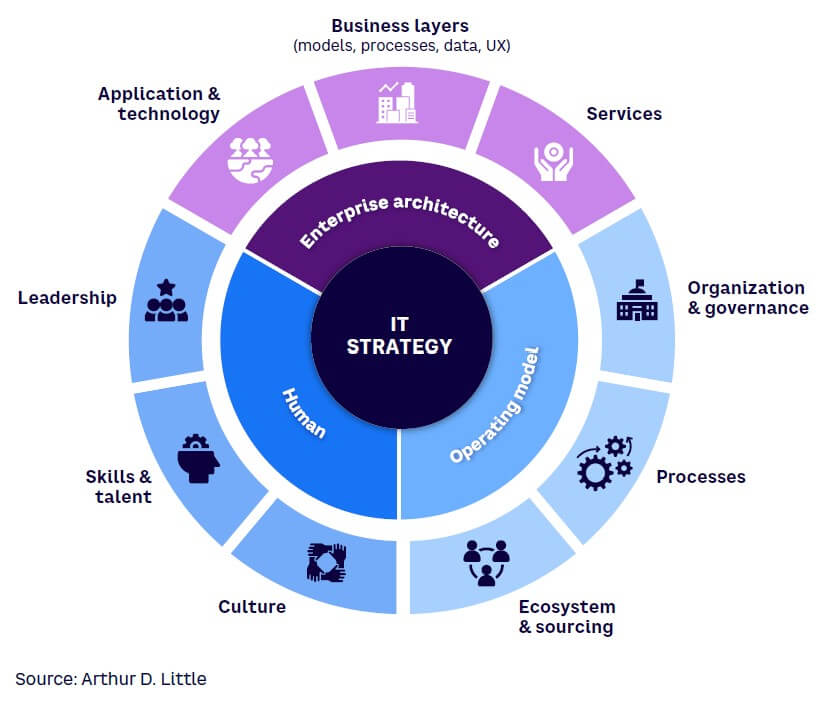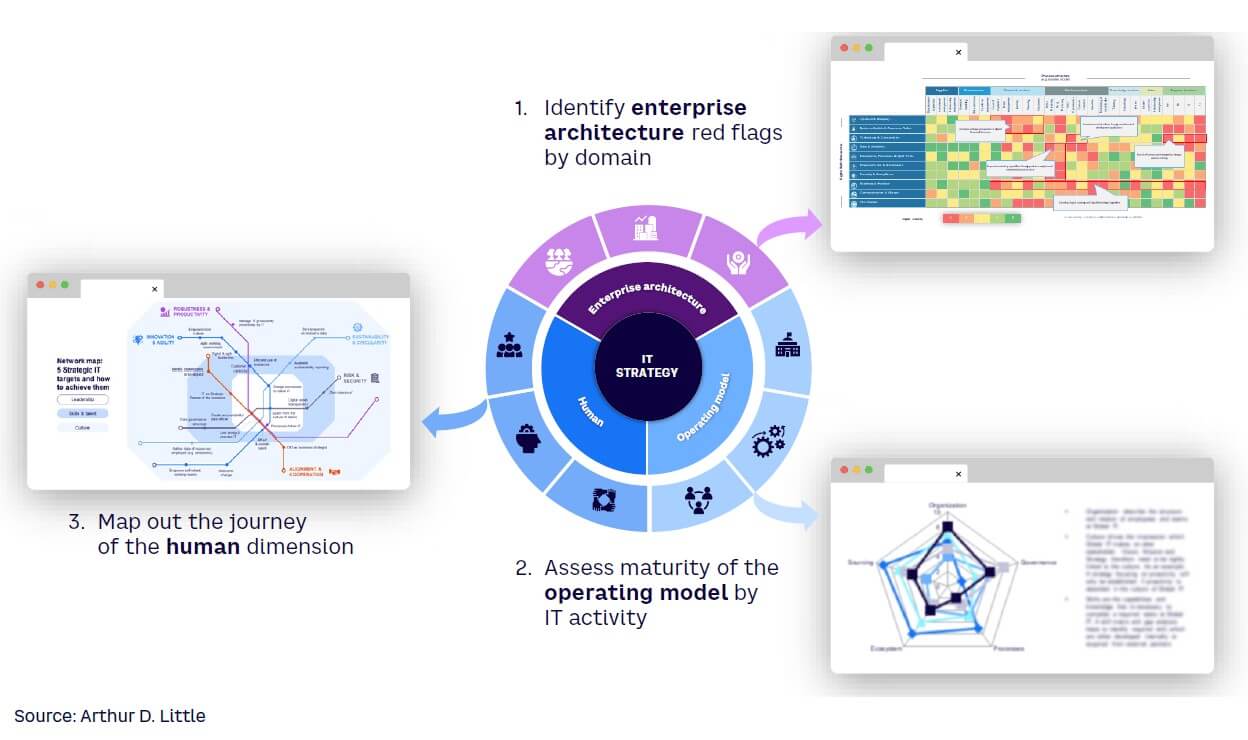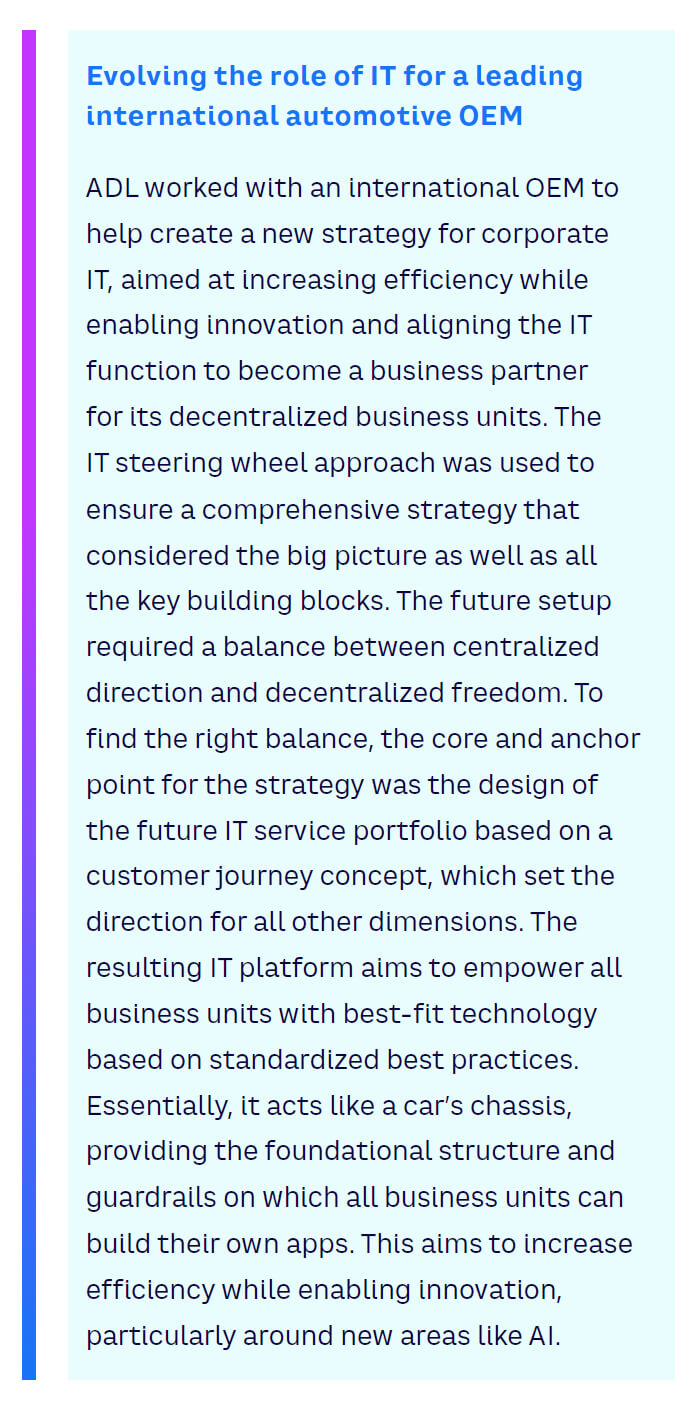
Digitalization has become embedded within large businesses, with recent advances in AI accelerating the process even further. While we still need more progress, the fusion of business and IT functions is ever present, as “softwarization” of companies proceeds apace. IT functions need to recognize this pace of change and evolve toward being true strategic advisers to the business, driving innovation. In this Viewpoint, we examine some practical approaches for CIOs to bring about change.
NEXT WAVE OF CHANGE
IT transformations have been the norm rather than the exception as far back as the 1990s. At that time, corporate IT focused mainly on managing infrastructure, maintaining hardware, and providing basic software support. The role changed significantly in the 2000s with the rise of the Internet and enterprise solutions and again over the last 15 years as digitalization completely transformed ways of doing business.
Today, we are again at the threshold of a new wave of change in the role of corporate IT. Several factors are coming together to drive this change:
-
Digitalization has already become embedded. Productivity boosts, which are core to the business, are virtually all IT- and data-driven, from robotic process automation to the Internet of Things, digital twinning, and cloud computing.
-
AI is revolutionizing ways of doing business. We are still only seeing the tip of the iceberg in terms of AI-driven productivity and efficiency improvements, with the prospect of entirely new AI-driven business models, products, and services on the horizon. New IT capabilities are key for this revolution.
-
Softwarization of business is proceeding apace. Product and process IT are increasingly integrated, leading to a fusing of business and IT — rather than IT being merely aligned to the business or else tailored to suit preexisting business processes.
-
New, transformative IT-based solutions are developing fast. From quantum computing to human augmentation, the pace of digital innovation is rapid, with potentially disruptive opportunities and threats approaching in uncertain time frames.
-
Ecosystem mastery has become a key differentiator for IT. Pressures on cost efficiency, increasing specialization, and the need for agility and innovativeness have driven IT functions toward increasing adoption of partner ecosystem approaches.
Together, these factors are leading to a new shift in the role of IT, where IT becomes a more strategic adviser to the business — driving innovation rather than being just a provider of IT services. As mentioned earlier, this is not the first time that IT has tried to reinvent itself in this way; similar initiatives were taking place 10 or even 20 years ago. Although transformation has always been challenging, many IT functions have already moved toward the goal of better alignment with business strategy and value creation.
But what’s different this time is the maturity of digitalization and the extent to which IT and business have already merged. For example, while the separation of CDO (chief digital officer) and/or CTO (chief technology officer) roles from the CIO role might have been the best path during the transition of integrating digitalization into the business, today this separation is much less useful. The idea of corporate IT becoming a true strategic adviser to the business makes a lot more sense and is a lot more impactful when the level of technology integration is already so high.
So what does this mean for how IT organizations should evolve themselves? What are the main strategic building blocks to focus on? Below, we provide some insights based on Arthur D. Little’s (ADL’s) recent experience working with various large organizations.
5 KEY CAPABILITIES
The starting point for change is understanding the needed capabilities. For IT functions to become effective strategic advisers to the business, they need to develop some key capabilities often underrepresented. ADL sees five such capabilities as being most important:
-
Innovation and agility. In many IT functions, agile ways of working have been only partly implemented. To be genuinely innovative, IT functions need to be properly organized for agility and adopted as the standard working paradigm, both within the function itself and across all interfaces toward the business. This has to be backed by a fully digital, open, and collaborative culture.
-
Robustness and productivity. To complement innovation and agility, IT functions also need to “keep their eye on the ball” in terms of optimizing performance and productivity, meeting the essential need to provide secure, trusted, and reliable platforms. This requires the capability to design processes from a business perspective, exploiting the full potential of technology from the outset, rather than applying and adapting technology to suit existing processes and ways of working.
-
Risk and security. As cybersecurity risks increase and IT systems become more decentralized and democratized (e.g., through advances in AI-driven software), IT functions need to develop stronger governance approaches for risk and security. This involves having a complete picture of all IT/OT assets and a zero-tolerance compliance/security strategy.
-
Sustainability and circularity. The IT function should provide the technology foundation to monitor and improve corporate sustainability targets. Moreover, companies need to achieve significant reductions in their IT energy consumption, with the ability to track, provide, and share auditable sustainability reporting data across ecosystems.
-
Alignment and cooperation. Ultimately, the IT function needs to develop new capabilities to act as a strategic partner to the business. Therefore, the CIO needs expert skills in business strategy and know-how to build strong links across the organization. Alignment can even extend to full business-IT fusion, with borders between departments completely dissolved.
BUILDING BLOCKS TO DELIVER REQUIRED CHANGE
As with any major change, to develop the IT function’s new capabilities as a strategic business adviser, there needs to be a comprehensive approach in place that addresses all the building blocks. Through our work with many leading organizations, ADL has successfully applied the “IT steering wheel” model to help ensure covering all the necessary dimensions (see Figure 1).

Let’s now turn to each of the three main sections: enterprise architecture (EA), operating model, and human.
Enterprise architecture
EA choices underpin the development of applications and deployment of technologies; the design of processes, systems, and data structures; and the availability of the right services. Yet, in many companies, the discipline is still not treated as a strategic priority, as highlighted in the ADL Viewpoint “Why Effectively Managing Enterprise Architecture Is Key to Transformation.”
As IT shifts toward the business strategist role, there are several areas of focus:
-
EA needs to clearly link to business architecture. One way to achieve this is for IT to help develop business strategy and processes, ensuring that IT’s services are fully transparent within the company.
-
The IT landscape needs to be optimized for performance, flexibility, and complexity, with strict streamlining of the IT portfolio, modular application programming interface (API) architectures, and a powerful integration layer to seamlessly connect solutions.
-
IT leaders must leverage state-of-the-art and emerging technologies where possible, acting as business consultants and drivers for change and adopting innovative solutions for strategic applications. The mindset and default approach must be AI and virtual reality everywhere, with efficiency delivered through the automation of IT and business processes.
-
There should be a focus on architecture standardization, rather than customization, adopting commercial off-the-shelf platforms that enable new technologies to be deployed quickly to drive business differentiation. Implementing this approach can be an issue for legacy architectures that have been heavily customized to support existing organizational processes. IT leaders must therefore educate and challenge the business, stressing the importance of removing the long tail of complexity to enable standardization.
-
CIOs should emphasize enforcement of security and compliance standards but adopt lean and smart governance and provide standard guardrails by factoring them into frameworks (e.g., security by design).
Operating model
Next, the IT operating model needs to be adapted as necessary to align with effective delivery of the strategic business partner role. In practice, this means several things:
-
Organizational design must realign around business needs and services, including the five key capabilities mentioned above. It should enable product-oriented IT development based on horizontal thinking, rather than following vertical lines. Features such as joint business/IT teams and cross-functional agile models are effective to break down silos and drive integration. Strong governance tailored to joint business/IT targets, such as green IT or innovation, is also important.
-
Processes need to be aligned. Typically, this may include designing entirely new processes as well as strengthening and adapting existing processes to enable the achievement of strategic targets. Creating a designated business partner role within IT can help promote close working with business function counterparts. Metrics help ensure that performance, productivity, and quality are actively managed.
-
CIOs need to strengthen their capabilities as partner ecosystem orchestrators. This involves building a strong supplier ecosystem through strategic partnerships that bring in specialized resources to overcome internal skills gaps. Expanding IT “as a service” (XaaS), applying cloud-native principles, and using standard platforms may be part of the approach. Focusing on core activities and outsourcing the rest to strategic suppliers can improve efficiency as well as maintain strategic clarity. Continually scanning ecosystems for upcoming business and technology trends is important, given the speed of market change.
Human
The human dimension is frequently underemphasized in favor of the other two, yet in many ways, it is the most important. Figure 2 shows some practical ways to create an open, digital-first, customer-centric culture that will help drive change toward IT becoming a strategic business partner.
As shown in Figure 2, the crux is to focus on empowerment, collaboration, action orientation, customer-centricity, constant change, and continuous innovation. It’s best to introduce practical steps (shown in the figure) rather than grand policy statements and lead by example rather than through words. These levers are not new but are surprisingly absent in many large IT functions.

The change in role for IT also means that CIOs need to develop different skills than in the past. Retraining is therefore an important aspect to consider, as well as new hires. Establishing a positive culture and working environment will pull the best out of the IT organization’s people and will help attract new talent and retain existing employees.
STARTING THE JOURNEY
To start making the shift, companies need to develop a clear picture of where they are today. The IT steering wheel offers a useful framework for making this initial assessment (see Figure 3):
-
Step 1. Identify where the “red flags” are in terms of EA. One way to do this is to develop a heat map that illustrates where the strengths and weaknesses are for each key dimension of interest across the range of IT architecture domains.
-
Step 2. Look at the various elements of the IT operating model and assess their maturity versus a well-established best practice model framework.
-
Step 3. This step covers the all-important human dimension and involves setting current status, clear destinations, and milestones for achieving progress in the five key capabilities mentioned above (innovation/agility, robustness/productivity, risk/security, sustainability/circularity, and alignment/cooperation). Once a clear picture of status, ambitions/goals, and challenges has been created, a tailored and actionable plan for change can be developed and implemented.

Conclusion
IT’s evolution to strategic adviser requires change in both capability & culture
Digitalization continues to transform business and society, with technologies like AI accelerating the pace of change once again. Already, the distinction between business and IT functions is blurring — and header toward further alignment. Thus, corporate IT functions need to be proactive in recognizing this ongoing integration and evolve themselves still further toward becoming a true strategic business partner. Doing this requires a comprehensive approach that addresses all the necessary building blocks. Above all, CIOs need to ensure they don’t neglect the human dimension. Without the necessary shifts in capability and culture, corporate IT is unlikely to reach its goals.








